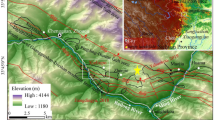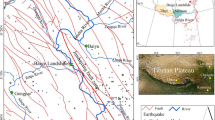Abstract
The reactivation of landslides has always been a prominent problem that has endangered town construction and people’s safety worldwide. At about 8 a.m. on July 12, 2018, on a mountain near the Bailong River in Nanyu Township, Zhouqu County, Gansu Province, China, a landslide collapse event occurred. About 10,000 m3 of sloped material slid into the Bailong River, with the largest stone reaching 3 m3. As a result, a large number of houses were flooded. Highways and bridges were destroyed. Using field investigations, unmanned aerial vehicle (UAV) photography, InSAR traces, historical records, and multiple remote sensing images, we extracted the landslide’s geometry and geomorphic parameters to quantify the characteristics of the Jiangdingya landslide. Based on high-resolution topographic data collected before and after the landslide, the change in the geomorphological factors, geomorphologic stability, and detection of the precursory motion before the landslide failure were analyzed to fully investigate the temporal geomorphological changes. Synthesizing the above research, we discuss the causes of landslide reactivation. The Jiangdingya landslide is a typical ancient landslide formed by the coupling of internal and external dynamics. Rainfall, seismic fault zone activity, human activities, and river erosion were the main causes of this reactivation event.












Similar content being viewed by others
References
Bayer B, Simoni A, Mulas M, Corsini A, Schmidt D (2018) Deformation responses of slow moving landslides to seasonal rainfall in the Northern Apennines, measured by InSAR. Geomorphology 308(1):293–306
Catane SG, Veracruz NAS, Flora JRR, Go CMM, Santos ERU (2019) Mechanism of a low-angle translational block slide: evidence from the September 2018 Naga landslide, Philippines. Landslides 16:1709–1719
Chen H (1991) Brief Introduction of Nanyu Large Landslide in Zhouqu County, Gansu. Northwest Hydropower 4:63
Cheng D, Cui Y, Su F, Jia Y, Choi CE (2018) The characteristics of the Mocoa compound disaster event, Colombia. Landslides 15:1223–1232
Cui Y, Cheng D, Choi CE, Jin W, Lei Y, Kargel JS (2019) The cost of rapid and haphazard urbanization: lessons learned from the Freetown landslide disaster. Landslides 16:1167–1176
Dai K, Li Z, Tomás R, Liu G, Yu B, Wang X, Cheng H, Chen J, Stockamp J (2016) Monitoring activity at the Daguangbao mega-landslide (China) using Sentinel-1 TOPS time series interferometry. Remote Sens Environ 186:501–513
Dai K, Xu Q, Li Z, Tomás R, Fan X, Dong X, Li W, Zhou Z, Gou J, Ran P (2019a) Post-disaster assessment of 2017 catastrophic Xinmo landslide (China) by spaceborne SAR interferometry. Landslides 16:1189–1199
Dai K, Zhuo G, Xu Q, Li Z, Li W, Guan W (2019b) Tracing the pre-failure two-dimensional surface displacements of Nanyu landslide, Gansu Province with Rader Interferometry. Geomatics Inform Sci Wuhan Univ 44(12):1778–1786
Darren T, Arko L, Steven DJ (2015) Time series analysis of landslide dynamics using an unmanned aerial vehicle (UAV). Remote Sens 7(2):1736–1757
Davis WM (1889) The rivers and valleys of Pennsylvania. Natl Geogra Soc.
Dong J, Liao M, Xu Q, Zhang L, Tang M, Gong J (2018) Detection and displacement characterization of landslides using multi-temporal satellite SAR interferometry: A case study of Danba County in the Dadu River Basin. Eng Geol 240:95–109
Fan X, Xu Q, Scaringi G, Zheng G, Huang R, Dai L, Ju Y (2018a) The “long” runout rock avalanche in Pusa, China, on August 28, 2017: a preliminary report. Landslides 16:139–154
Fan X, Zhan W, Dong X, Van Westen CJ, Xu Q, Dai L, Yang Q, Huang R, Havenith HB (2018b) Analyzing successive landslide dam formation by different triggering mechanisms: the case of the Tangjiawan landslide, Sichuan, China. Eng Geol 243:128–144
Fu X (2017) Research on revival mechanism and stability of disturbed ancient landslide. Xihua University, Chengdu
Guo C, Zhang Y, Montgomery DR, Du Y, Zhang G, Wang S (2016) How unusual is the long-runout of the earthquake-triggered giant Luanshibao landslide, Tibetan Plateau, China? Geomorphology 259(15):145–154
Guo C, Ren S, Li X, Zhang Y, Yang Z, Wu R, Jin J (2019) Development characteristics and reactivation mechanism of the Jiangdingya ancient landslide in the Nanyu Town, Zhouqu Country, Gansu Province. Geoscience 33(1):206–217
Guo C, Zhang Y, Li X, Ren S, Yang Z, Wu R, Jin J (2020) Reactivation of giant Jiangdingya ancient landslide in Zhouqu County, Gansu Province, China. Landslides 17:179–190
Handwerger AL, Roering JJ, Schmidt DA (2013) Controls on the seasonal deformation of slow-moving landslides. Earth Planet Sci Lett 377-378:239–247
Hu S, Qiu H, Wang X, Gao Y, Wang N, Wu J, Yang D, Cao M (2018) Acquiring high-resolution topography and performing spatial analysis of loess landslides by using low-cost UAVs. Landslides 15:593–612
Hu S, Qiu H, Pei Y, Cui Y, Xie W, Wang X, Yang D, Tu X, Zou Q, Cao P, Cao M (2019) Digital terrain analysis of a landslide on the loess tableland using high-resolution topography data. Landslides 16:617–632
Lacroix P, Bièvre G, Pathier E, Kniess U, Jongmans D (2018) Use of Sentinel-2 images for the detection of precursory motions before landslide failures. Remote Sens Environ 215:507–516
Ma S, Xu C, Shao X, Zhang P, Liang X, Tian Y (2018) Geometric and kinematic features of a landslide in Mabian Sichuan, China, derived from UAV photography. Landslides 16:373–381
Marko K, Holley R, Mahapatra P, Marel HVD, Bavec M (2015) Coupling of GPS/GNSS and radar interferometric data for a 3D surface displacement monitoring of landslides. Landslides 12:241–257
Martino S, Antonielli B, Bozzano F, Caprari P, Discenza ME, Esposito C, Fiorucci M, Iannucci R, Marmoni GM, Schilirò L (2020) Landslides triggered after the 16 August 2018 Mw 5.1 Molise earthquake (Italy) by a combination of intense rainfalls and seismic shaking. Landslides 17:1177–1190
Mu P (2011) Analysis on causes and stability of landslide at Jiangdingya in Zhouqu County of Gansu. China Water Resour 4:50–52
Ouyang C, Zhao W, Xu Q, Peng D, Li W, Wang D, Zhou S, Hou S (2018) Failure mechanisms and characteristics of the 2016 catastrophic rockslide at Su village, Lishui, China. Landslides 15:1391–1400
Pasternack GB, Wyrick JR (2017) Flood-driven topographic changes in a gravel-cobble river over segment, reach, and morphological unit scales. Earth Surf Process Landf 42(3):487–502
Qiu H, Cui P, Hu S, Liu Q, Wang Y, Gao Y (2016) Size-frequency distribution of landslides in different landforms on the Loess Plateau of Northern Shaanxi. Earth Sci 41(2):343–350
Qiu H, Cui P, Regmi AD, Hu S, Wang X, Zhang Y, He Y (2017) Influence of topography and volume on mobility of loess slides within different slip surfaces. Catena 157:180–188
Qiu H, Cui P, Regmi A, Hu S, Wang X, Zhang Y (2018) The effects of slope length and slope gradient on the size distributions of loess slides: Field observations and simulations. Geomorphology 300:69–76
Qiu H, Cui Y, Pei Y, Yang D, Hu S, Wang X, Ma S (2020) Temporal patterns of nonseismically triggered landslides in Shaanxi Province, China. Catena 187:104356
Shahverdian S, Macfarlane W, Stevens G, Meier M, Wheaton JM (2017) Geomorphic response to Pilot River Restoration on the San Rafael River. A Pilot Installation of Beaver Dam Analogues, Utah Retrieved from https://doi.org/10.13140/RG.2.2.18963.37928
Singleton A, Li Z, Hoey T, Mullerc JP (2014) Evaluating sub-pixel offset techniques as an alternative to D-InSAR for monitoring episodic landslide movements in vegetated terrain. Remote Sens Environ 147:133–144
Song S (2014) Formation mechanism analysis of Cuifengshan landslide in Lingshi County. Shanxi Architecture 40(36):74–75
Strahler AN (1952) Hypsometric (area-altitude) analysis of erosional topography. Geol Soc Am Bull 63(11):1117–1142
Sun Q, Zhang L, Ding X, Hu J, Li Z, Zhu J (2015) Slope deformation prior to Zhouqu, China landslide from InSAR time series analysis. Remote Sens Environ 156:45–57
Teshebaeva K, Echtler HP, Bookhagen B, Strecker MR (2019) Deep-seated gravitational slope deformation (DSGSD) and slow moving landslides in the southern Tien Shan Mountains: new insights from InSAR, tectonic, and geomorphic analysis. Earth Surf Process Landf 44:2333–2348. https://doi.org/10.1002/esp.4648
Tian S, Chen N, Wu H, Yang C, Zhong Z, Rahman MM (2020) New insights into the occurrence of the Baige landslide along the Jinsha River in Tibet. Landslides 17:1207–1216
Tomás R, Li Z, Lopez-Sanchez JM, Liu P, Singleton A (2016) Using wavelet tools to analyse seasonal variations from InSAR time-series data: a case study of the Huangtupo landslide. Landslides 13:437–450
Wang G (2013) Lessons learned from protective measures associated with the 2010 Zhouqu debris flow disaster in China. Nat Hazards 69(3):1835–1847
Wang J, Qi L, Cui X (1994) Analysis on landslide of Nanyu in Zhouqu county of Gansu province. Bull Soil Water Conserv 14(1):57–60
Wartman J, Montgomery DR, Anderson SA, Keaton JR, Benoît J, Chapelle J, Gilbert R (2016) The 22 March 2014 Oso landslide, Washington, USA. Geomorphology 253(15):275–288
Wheaton JM (2014) Trends and challenges in geomorphic change detection. Retrieved from https://doi.org/10.13140/RG.2.2.26758.68167
Xu J (2015) Discussion on causes and prevention and control measure of landslide geological disasters in Yuci Beishan. Shanxi Archit 41(24):85–86
Yan Y, Cui Y, Tian X, Hu S, Liao L (2020) Seismic signal recognition and interpretation of the 2019 “7.23” Shuicheng landslide by seismogram stations. Landslides 17:1191–1206
Yang W, Huang X, Zhang C, Liu T (2013) The deformation characteristics of the landslide along Pingding-Huama active fault zone and its prevention and control. Geol Bull China 32(12):1925–1935
Yang W, Huang X, Zhang C, Si H (2014) Deformation behavior of landslides and their formation mechanism along Pingding-Huama active fault in Bailongjiang River region. J Jilin Univ (Earth Sci Ed) 44(2):574–583
Yang W, Wang Y, Sun S, Wang Y, Ma C (2019) Using Sentinel-2 time series to detect slope movement before the Jinsha River landslide. Landslides 16:1313–1324
Yuan Y, Zheng W, Zheng Y, Zhu S (1998) The characteristics of the Baitukan Landslide in Kangdin, Sichuan and its countermeasures. Chin J Geol Hazard Control 9(S1):235–241
Zeng Y (2010) Research on the mechanism of groundwater in reactivating of old landslides on Reservoir Bank. China University of Geosiences Wuhan China
Zhang N (2018) Study on formation mechanism and comprehensive prevention of debris flow disasters in Sanyanyu valley, Zhouqu China. University of Geosciences Wuhan China
Zhang F, Huang X (2018) Trend and spatiotemporal distribution of fatal landslides triggered by non-seismic effects in China. Landslide 15(8):1663–1674
Zhang F, Wang G, Kamai T, Chen W, Zhang D, Yang J (2013) Undrained shear behavior of loess saturated with different concentrations of sodium chloride solution. Eng Geol 155(6):69–79
Zhang Y, Meng X, Chen G, Qiao L, Zeng R, Chang J (2016) Detection of geohazards in the Bailong River Basin using synthetic aperture radar interferometry. Landslides 13:1273–1284
Zhang Y, Wu R, Guo C, Wang L, Yao X, Yang Z (2018) Research progress and prospect on reactivation of ancient landslides. Adv Earth Sci 33(7):728–740
Zhou S, Ouyang C, An H, Jiang T, Xu Q (2020) Comprehensive study of the Beijing Daanshan rockslide based on real-time videos, field investigations, and numerical modeling. Landslides 17:1–15
Zhuang J, Peng J (2014) A coupled slope cutting—a prolonged rainfall-induced loess landslide: a 17 October 2011 case study. Bull Eng Geol Environ 73:997–1011
Funding
This work was funded by the Second Tibetan Plateau Scientific Expedition and Research Program (STEP) (Grant No. 2019QZKK0902), International Science & Technology Cooperation Program of China (Grant No. 2018YFE0100100), National Natural Science Foundation of China (Grant No. 41771539), Strategic Priority Research Program of Chinese Academy of Sciences (Grant No. XDA20030301), International Partnership Program of Chinese Academy of Sciences (Grant No. 131551KYSB20160002), China Postdoctoral Science Foundation (Grant No. 2019 M663792), and Scientific Research Foundation of Northwest University (Grant No. 360051900075).
Author information
Authors and Affiliations
Corresponding author
Rights and permissions
About this article
Cite this article
Ma, S., Qiu, H., Hu, S. et al. Characteristics and geomorphology change detection analysis of the Jiangdingya landslide on July 12, 2018, China. Landslides 18, 383–396 (2021). https://doi.org/10.1007/s10346-020-01530-3
Received:
Accepted:
Published:
Issue Date:
DOI: https://doi.org/10.1007/s10346-020-01530-3




